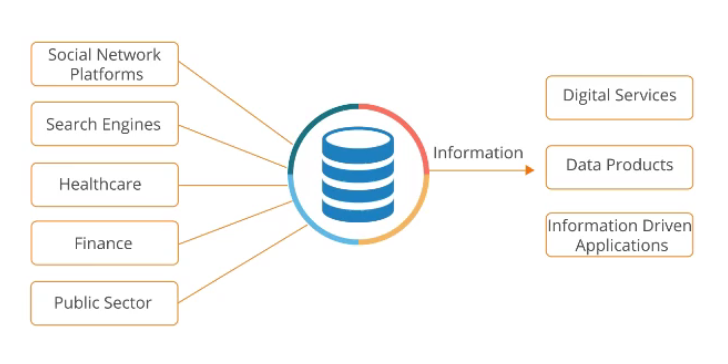
Data science also helps to manage an enormous amount of data effectively. So, what are these various sectors doing with all that big data? Their team of scientists analyzes all raw data using modern algorithms and data models to transform them into information. They then use all of that information to develop digital services, data products, and information-driven applications.
Social network platforms such as Google, Yahoo, Facebook and So on, collect a lot of data every day, which is why they have some of the most advanced data centers spread across the world. Having data centers all over the world, and not just in the United States help their international clients better and faster without any network latency.
Using Data Science – Social Network Platforms
LinkedIn – They use its users’ data points to provide them with relevant digital data services and products. If you are a software engineer based in London, then you will want to see the groups.
Now, what LinkedIn is done with the help of data science is that it looks to your profile, posts and likes, and what city you are from, the people you are connected to and the groups you belong to and matches all these points in their database and provide you the information that is most relevant to you.
This information could be in the form of News updates that you are interested in, industry connections or professional groups that you might want to get in touch with or even job postings related to your field and designation, these are all examples of digital services.
Using Data Science – Search Engines
Google – They use data science to provide meaningful search recommendations, even when users begin to type a query. Google search has the most unique search algorithm which allows machine learning models to provide relevant search recommendations even when the user types his search query, this feature is called auto complete. This is a great example of how powerful a machine learning algorithm is.
There are several factors that influence these features: –
- Query Volume – Google’s algorithm finds unique and verifiable users that search for any particular keyword on the web, based on which it builds the query volume.
- Geographical locations – Google’s algorithm tags a query with locations from where it is generated, this makes the query volume location specific. It’s a very important feature because it allows google to provide relevant search recommendations to its users based on his/her location.
- keyword/phrase matches on the web – Google’s algorithms take the keywords and phrases that the user types in and crawls the web to find the similar instances.
- Some scrubbing for inappropriate content – Google’s algorithms also try to scrub/filter the inappropriate content for instance Sexual Violence or terrorism related content, hate speeches and legal cases are scrubbed out of search recommendations.
Using Data Science – Healthcare
Wearable devices use Data Science to analyze data gathered by their biometric sensors. Today even the healthcare industry is beginning to tap into the various applications of data science.
To understand this, let’s look into wearable devices, these devices has
- Biometric sensors
- Built-in processor to gather data from your body when you are wearing them.
Wearable devices transmit this data to the big data analytics platform via the IOT Gateway. Ideally, the platform collects hundreds to thousands of data points and the collected data is then ingested into the system for further processing.
The Big Data Analytics Platform applies its data models, created by data scientists and extract the information that is relevant to you. It sends the information to the engagement dashboard, where you can see how many steps you’ve walked, what your heart rate is over the period of time, how good your sleep was, how many calories you have burned and so on. Knowing such details, will help you to set your personal goals for healthy lifestyle and reduce overall healthcare and insurance costs and it will also help your doctor to record your vitals and diagnose any issue.
Using Data Science – Finance
Finance sector can easily use data science to help it function more efficiently. A Loan Manager can easily access and sift through a loan applicant’s financial details using Data Science.
Suppose a person applies for a loan, the loan manager submits the application to the enterprise infrastructure for processing, the analytics platform applies data models and algorithms and creates an engagement dashboard for the loan manager. The dashboard will show the applicant’s credit reports, credit history, approved amount and risks associated with him or her, then the loan manager can easily take a look at all the relevant information and decide whether the loan can be approved or not.
Using Data Science – Public Sector
Governments across countries are gradually sharing the large data sets from various domains with the public. This kind of transparency makes the government seem more trustworthy, it provides the country data that can be used to prepare itself for different types of issues like climate change and disease control. It also helps encourage people to build their own digital products and services.
The US government has hosted Data.gov which provides around 195,469 Datasets, which can be used for strategic initiatives using data science that uses digital service and open data.
